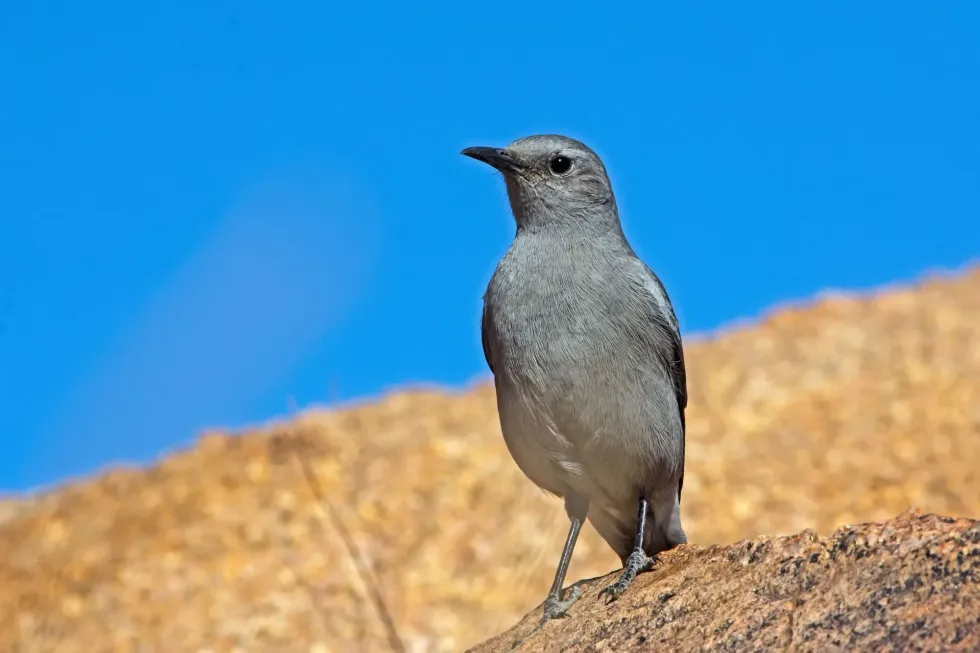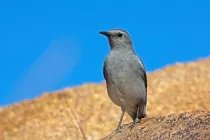The Karoo chat is a simple yet charming neutral-colored bird that you are bound to love! Hermann Schlegel, a German ornithologist, came up with the name for this species of the Muscicapidae genus and this bird is endemic to South Africa.
It is known as the Karoospekvreter in Afrikaans, the Bleichschmätzer in German, and the traquet du Karroo in French.
This bird resembles the mountain weather bird and the only way to tell these birds apart from other birds of southern Africa is by taking a close look at their legs and tail. In the case of the Karoo chat, these legs and tails are slender and V-shaped.
Read along to learn some interesting facts about the Karoo chat. You can also check out our secretary bird facts and tawny owl facts too.
Karoo Chat Interesting Facts
What type of animal is a Karoo chat?
The Karoo chat is a tiny passerine bird in the Muscicapidae family of Old World flycatchers.
What class of animal does a Karoo chat belong to?
The Emarginata schlegelii species belongs to the class Aves of the Animalia kingdom.
How many Karoo chats are there in the world?
The Karoo chat is distributed over a wide range so its population is large in number. However, the precise population size of this species is difficult to ascertain. The range of their resident occurrence is 768343.3 sq mi (1,990,000 sq km).
Where does a Karoo chat live?
The Emarginata schlegelii species is near-endemic to South Africa (meaning that the majority of its population is limited to South Africa). The Karoo chat is also common in southwestern Angola and dry parts of Namibia. Their population is concentrated in the southwestern Karoo desert and is sparse in the rest of the continent of Africa.
What is a Karoo chat's habitat?
This bird's natural habitat is the arid zone in the Karoo desert and in the north Namibian plains. This species is a common resident in the green fertile areas of enormous thickets of South Africa and southwestern Angola. It spends most of its time on the savannahs feeding and breeding.
Who do Karoo chats live with?
The Emarginata schlegelii species is found living either singly or in pairs. This species forms monogamous relationships and mature Karoo chats enjoy living as couples to guard their territory during the breeding season. After hatching, the young bird flees the parental area to live on its own.
How long does a Karoo chat live?
The lifespan of this bird is yet to be discovered. Various studies are being conducted in South Africa to find this out.
How do they reproduce?
Reproduction in the Emarginata schlegelii species is achieved by internal fertilization. These birds reproduce at any time, so the breeding season can occur at any time of the year.
However, spawning tends to stick to a particular timeframe between August and mid-March. The bird lays two to four green eggs with yellow undertones and rust blotches on nests made of straw and leaves.
The nest is placed on the ground beneath a bush for shade and protection from predators like eagles and vultures. The eggs hatch after a 15 day incubation period.
What is their conservation status?
As per the IUCN Red List, these birds are placed under the Least Concern category. This is because it has been estimated that the decline of these birds will be less than 30% in the next three generations.
Karoo Chat Fun Facts
What do Karoo chats look like?
One of the main characteristics that help in the identification of Karoo chat birds from other birds of southern Africa is the species' long black tail that is fringed with white tail feathers. Also, their upper body is entirely gray.
This species has black legs and black feet, in contrast to their white bosom and belly feathers. Each eye is small and brown, and has a rust patch on the side.
We've been unable to source an image of a Karoo chat and have used an image of the Luscinia svecica bird instead. If you are able to provide us with a royalty-free image of a Karoo chat, we would be happy to credit you. Please contact us at hello@kidadl.com
How cute are they?
The small stature, gray color, and high pitch call of this bird make for an appealing image. This bird, true to its appearance, is generally peaceful.
How do they communicate?
Birds of the Emarginata schlegelii species communicate among themselves by sending out call notes. These are brief sounds emitted by birds that we may refer to as chirps. They can also convey messages through their body language and behavior.
This bird has a broad spectrum of calls. Younger birds' companion calls, alarm calls, and hunger calls are the most well-known. Their call is distinct and may consist of double notes like 'chak-chak' or even triple notes like 'turret tat tut'.
How big is a Karoo chat?
The Emarginata schlegelii species is around 6.2-7 in (16-18 cm). This bird is twice the size of a hummingbird.
How fast can a Karoo chat fly?
This bird can be seen traveling singly or in pairs at a speed range of 30-36 mph (26-31 kph) during migration. At other times the flight speed depends upon the individual bird's ability.
How much does a Karoo chat weigh?
This bird weighs between 0.05-0.66 lb (0.023-0.031 kg).
What are their male and female names of the species?
These birds of southern Africa do not possess any specific names for males and females. They are simply referred to as Karoo chat (Emarginata schlegelii) birds.
What would you call a baby Karoo chat?
Young Karoo chats from this species of birds that are almost endemic to South Africa can be called chicks or hatchlings.
What do they eat?
Insects make up a large portion of their diet. This bird consumes honey thorns, butterflies, bees, wasps, locusts, caterpillars, and seeds in smaller quantities. Aside from that, they may be spotted devouring termites from the ground.
Are they friendly?
Emarginata schlegelii birds often reside near human dwellings. These birds are not afraid of human contact and are quite sociable.
Would they make a good pet?
Although these birds are at ease around humans and may be kept as pets, they are not as sociable as parrots. Perhaps they are better off in the wild.
Did you know...
This monogamous bird is secretive during its breeding seasons.
This gray bird despises the summer. Therefore, during the summer, it is difficult to detect this bird.
In an attempt to entice a predator away from the nest and their young birds, adult Emarginata schlegelii birds can imitate an injured bird.
Types of Karoo chat
The Karoo chat has four subspecies. Emarginata schlegelii benguellensis is a subspecies that is spotted in southwest Angola. Emarginata schlegelii namaquensis is most common in southern Namibia and northwestern South Africa.
Emarginata schlegelii schlegelii is a subspecies that is native to coastal Namibia and Emarginata schlegelii pollux is the scientific name for the gray rumped Karoo chat. This is a subspecies that is frequently seen in southwestern and central South Africa. These birds of the Muscicapidae family look alike with minute differences that can help with their identification.
Why is it called Karoo chat?
The Karoo desert is a semi-desert region in South Africa. This is the native habitat of the Emarginata schlegelii species. The word 'chat' refers to a group of tiny birds with high-pitched call sounds (songbirds). The name Karoo chat was given to this bird since it is small and produces loud chirps and is found in the Karoo desert.
Here at Kidadl, we have carefully created lots of interesting family-friendly animal facts for everyone to discover! Learn more about some other birds from our umbrellabird facts and mockingbird facts pages.
You can even occupy yourself at home by drawing one of our free printable Karoo chat coloring pages.









